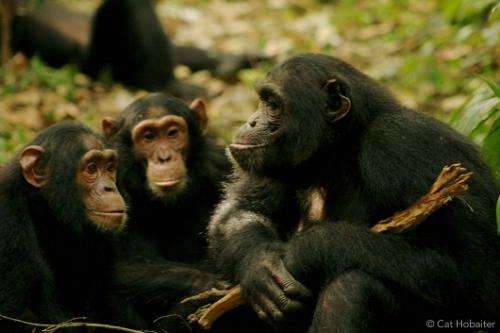July 7, 2014 report
Researchers decode gestures used by chimpanzees to communicate with each other

(Phys.org) —A team of researchers has, for the first time, decoded gestures used by chimpanzees in the wild to communicate with one another. In their paper published in the journal Current Biology, the team, led by primatologists Richard Byrne and Catherine Hobaiter describe how they videotaped a group of chimps living in a forest in Uganda, and then studied the gestures of the chimps and found repeated use of the same gestures by different members to convey the same ideas. All in all they tabulated 66 gestures, that when used in certain ways, resulted in conveyance of 19 unique communication transactions.
Scientists have known for years that chimps use gestures to convey information to one another and even to other animals. But until now, no one has been able to figure out what each gesture actually means. Finding out required watching hours of video, noting the use of 4,500 different instances of gestures and the reactions they caused, then comparing those same gestures as used by other chimps. The result is a dictionary of sorts, with gestures related to explicit meanings such as "take what I am giving you", "follow me" or "stop doing what you are doing."
The researchers report that some gestures appear to be used to convey more than one idea—grabbing someone else for example can be used as a means for telling them to stop doing something, to tell them to get away, or when directed at a youngster to offer a ride on their back. Other gestures, the team notes were more direct and only used for a specific purpose. Nibbling on a leaf, while making sure to be watched, was always part of a sexual advance.
The researchers claim their evidence is very clear—multiple chimps using the same gesture to convey the same idea, such as extending a rear foot to a young chimp to climb aboard, was universal—proving that some gestures used by the chimps, are very clearly a means of communicating a clear message. Such a finding, they note, marks a first—until now, only humans have been thought to be able to communicate with one another in such a direct way. The team notes that it makes sense—chimps are more closely related to humans than they are to other apes. Thus, it would only make sense that they would have similar, if less advanced communication skills.
More information: "The Meanings of Chimpanzee Gestures." Hobaiter, Catherine et al. Current Biology (2014) www.cell.com/current-biology/a … 0960-9822(14)00667-8
Abstract
Chimpanzees' use of gesture was described in the first detailed field study, and natural use of specific gestures has been analyzed. However, it was systematic work with captive groups that revealed compelling evidence that chimpanzees use gestures to communicate in a flexible, goal-oriented, and intentional fashion, replicated across all great ape species in captivity and chimpanzees in the wild. All of these aspects overlap with human language but are apparently missing in most animal communication systems, including great ape vocalization, where extensive study has produced meager evidence for intentional use. Findings about great ape gestures spurred interest in a potential common ancestral origin with components of human language]. Of particular interest, given the relevance to language origins, is the question of what chimpanzees intend their gestures to mean; surprisingly, the matter of what the intentional signals are used to achieve has been largely neglected. Here we present the first systematic study of meaning in chimpanzee gestural communication. Individual gestures have specific meanings, independently of signaler identity, and we provide a partial "lexicon"; flexibility is predominantly in the use of multiple gestures for a specific meaning. We distinguish a range of meanings, from simple requests associated with just a few gestures to broader social negotiation associated with a wider range of gesture types. Access to a range of alternatives may increase communicative subtlety during important social negotiations.
Journal information: Current Biology
© 2014 Phys.org




















